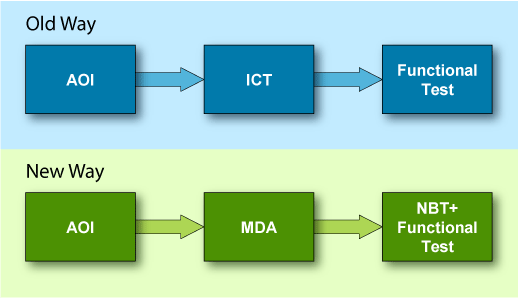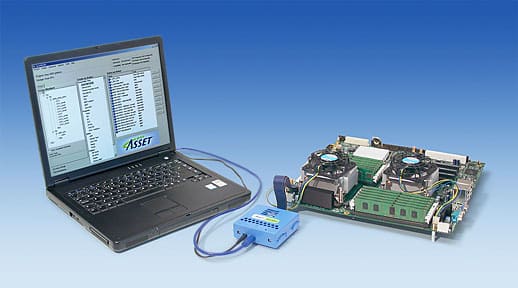As testing with legacy equipment becomes more problematic, engineers look for better ways to improve test coverage, enhance diagnostics, and speed up test times. But an overriding consideration is the cost of test – are the new test technologies more or less expensive than older solutions like ICT?
Test access is disappearing. This is a universally known truth within Test Engineering, and is referred to within numerous industry forums on the subject. The annual Board Test Workshop in particular has addressed this issue in various presentations, for example, Processor-Controlled Test – Updates and Requirements by Jeff Moore of EMC and (most humorously) Is ICT Dead and Does Anybody Care?” by Steve Butkovich of Cisco.

Certainly the trend towards higher circuit board densities and complexity, combined with a preponderance of high-speed I/O, such as PCIe Gen3 at 8GT/s, eliminates the possibility of putting down test points and thus makes traditional, intrusive In-Circuit Test (ICT) access problematic.
This is all well-understood, and it is also widely recognized that non-intrusive test strategies hold out the possibility of a solution. But how do the costs of intrusive versus non-intrusive solutions differ? There is always a large amount of inertia associated with changing tried-and-true test strategies, even if the value that they bring over time is diminishing. It’s particularly true that anything that drives the cost of test up will be the subject of a great amount of skepticism. So can non-intrusive board test (NBT) solutions address the coverage/diagnostics/beat rate issues and drop the cost of test by perhaps 50%?
Let’s take a look at this. By adopting an NBT strategy, savings come in three areas: capital costs, fixturing costs, and lifecycle costs.
Capital Costs
Assume for a moment that ICT is currently used in a hypothetical production line to do (1) unpowered testing looking for gross shorts and opens, (2) discrete component value measurement, and (3) powered testing. Assume further that (2) can be accomplished via measurements off a reel, and that (3) can be accomplished by a combination of NBT and functional test solutions. This could eliminate the high cost of heavy-metal ICT and have it replaced by an unpowered test solution, such as a Manufacturing Defect Analyzer (MDA).

ICT can be replaced by MDA and NBT
In the interest of not increasing the number of test steps, the cheaper MDA would replace the ICT, and NBT would be combined with the Functional Test step. This latter change is easy to do because NBT is mostly software.
Your mileage may vary, but we can assume that a new ICT is approximately $250,000 whereas the MDA can be had for $100,000 or less. This is of course dependent upon configuration, supplier, hardware and software options, and so on. But for a given production line the savings from moving powered testing to NBT would be $250,000 – $100,000 = $150,000.
Fixturing Costs
The cost of a fixture for a given design will vary substantially, based on everything from the size of the fixture to whether additional ICT electronics (i.e. hybrid cards) are needed to support it. Prices will in general range from $3 – $10/node (for references see this Agilent page and this Lucent case study); let’s assume a mid-range of $7/node.
Given a fairly large design of say 4,000 nodes and further assuming that 75% of those test points can be eliminated through the use of NBT, this represents a savings of 75% X 4,000 X $7 = $21,000.

ASSET's ScanWorks® Platform – a single environment for multiple NBT technologies
Lifecycle Costs
There are a number of less tangible but still important factors in choosing a software-based, non-intrusive test strategy versus continuing with solely an ICT strategy. Among these are:
- ICT hardware maintenance costs are substantially reduced because NBT is implemented primarily in software.
- NBT, being software, can be implemented instantly anywhere across the globe using floating licenses.
- Fixture maintenance (as probes wear out) is greatly reduced.
- NBT is easily deployed at repair sites (equipment footprint is smaller and cheaper).
- Fewer fixture re-spins based upon Engineering Change Orders.
- Lower test development costs – based upon a smaller ICT program.
- Lower fixture development costs – based upon a smaller fixture.
- NBT can supplement or replace legacy functional tests, reducing overall test time and providing much higher coverage and better diagnostics.
It’s hard to put a precise number on these savings, because they will vary so much from product to product. However, there’s no doubt that these intangible benefits are in the tens of thousands of dollars.
The Bottom Line
In the example above, it’s clear to see that moving to NBT gives a saving of greater than $200,000 per new production line. Offset this with the cost of a new NBT station of $25,000 or less and the ROI is incredible.
And test access is going away anyway.


